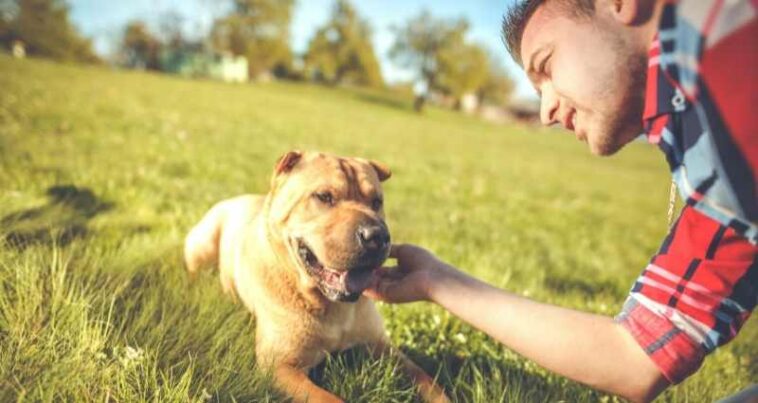What Should I Do If I’m Afraid Of My Own Dog?
Table of Contents
There is no definitive answer, as every dog is different. Some people may be afraid of their own dog because the dog is aggressive and barks or growls at them. In other cases, it may be because the person feels that they are not in control of the dog.
Ultimately, it is important to be proactive in training your dog and establishing a relationship of trust and respect. This will help to ensure that your dog understands that you are the pack leader, and will be less likely to exhibit aggressive behavior.
Understand that many things can make a dog aggressive, including illness, pain and socialization skills (i.e., they don’t learn how to get along with other people and other animals).
Lack Of Trust
One potential explanation for a dog being aggressive toward its owner could be due to a lack of trust. If a dog has been hit, yelled at, hurt or abused by its owner, it may not trust that individual and may become aggressive as a result. This is often the case with dogs adopted from certain shelters or pet stores that rely on puppy mills.
Alternatively, a dog may become aggressive out of fear if it perceives that its owner feels threatened. If a dog’s owner is fearful of aggression or shows any signs of anxiety during an interaction, the animal may sense it and feel the need to become defensive.
It’s important to build a relationship with your dog based on trust and respect. Your dog will be more likely to listen to you if they understand who is in charge!
The following tips may help to reduce the risk of your dog becoming aggressive toward you:
1. Be Responsible
Be sure to keep an eye on your puppy when you are in other settings, or even at home when you have company. There may be an instance or event that happens you are not aware of that can trigger fear in your dog, resulting in reactionary behavior.
If your dog is exhibiting any type of aggressive behavior toward you, the owner, you must be 100% responsible for how and when your dog is with others. Do not allow children or strangers to approach and interact with your dog without proper supervision. This includes talking to them, making eye contact, and patting them on top of their head.
Other people are not always considerate and careful of dogs. Things people often perceive as cute, such as allowing a child to sit on the dog, may be seen by your dog as a form of predatory behavior, and may elicit a fear response.
2. Limit Guarding Behavior
Do not allow your dog to guard items, such as food or chew toys. It’s important to get your puppy or dog used to you touching the food bowl, touching them when they are eating, and normalizing the food as something that they have access to without fear.
If they are allowed to show guarding behavior of the food bowl or toys, this may lead to aggression if someone approaches when they are eating.
3. Fun Exercise
Ensure that your dog gets plenty of exercise and mental stimulation, as this can increase their confidence and reduce the risk of them becoming anxious or frustrated. Tug-of-war games are fine as long as they are FUN, and not an “I won, you lost” environment for either of you. Tug, pet, let them win sometimes, and definitely teach “Out!”. If you see your pup getting too worked up, move on to another activity.
4. Learn More
Obtain an appropriate training certification/qualification. Reach out to your local AKC chapter for information on earing a Canine Good Citizen certificate. This will help to ensure you are using safe training methods with your dog.
5. Get A Check-Up
Be aware of medical conditions that may increase their anxiety or frustration, such as epilepsy and cognitive dysfunction. Share your dog’s behavior with your vet, and talk to them about your fear.
6. Ditch The Dog Parks
If your dog is aggressive with other dogs, do not take them to places where there are likely to be other dogs (e.g., the park). Dog parks are a human invention, and can be a difficult and even dangerous environment for your dog, particularly as a pup. Do take them for walks where there are people and activity.
7. Don’t Assume Your Dog Thinks Like You
If you are living with a partner, or have frequent guests in your home, do not assume that they will be able to control your dog. If you do leave them in charge, you need to tell them how to act around your dog and where it should and shouldn’t be allowed (e.g., on the couch). You should also try not to transfer your fear to others. Your dog will pick up on it.
A Word About Food Aggression In Dogs
One of the most common types of issues is food aggression in dogs. Dogs who are food-driven will often become aggressive when they see someone or something they perceive as a threat to their food – even you! This can be a problem, especially if you have a dog who is food-driven and also lives in a household with small children.
There are a few things that you can do to help prevent and manage food-related aggression in your dog. The most important thing is to make sure that you are always providing your dog with plenty of food and that he isn’t feeling threatened or stressed when he is eating. You should refrain from leaving food out all the time in areas where your dog can access it easily, as this could cause problems with resource guarding.
For puppies, you can teach them not to be aggressive toward food by touching their food bowl when they are eating, feeding them by hand out of their food bowl, and just randomly touching it during times when they are eating, letting them know that they need to have no fear.
Partnership With Your Pup
In order to have the best relationship possible with your dog, it’s important to have pack rules. Any dog who has no leader, or thinks she is the leader, can be dangerous. A relationship of love, trust and respect with your dog are key. If your dog is aggressive toward you or others, call an experienced dog trainer near you that you can work with.


